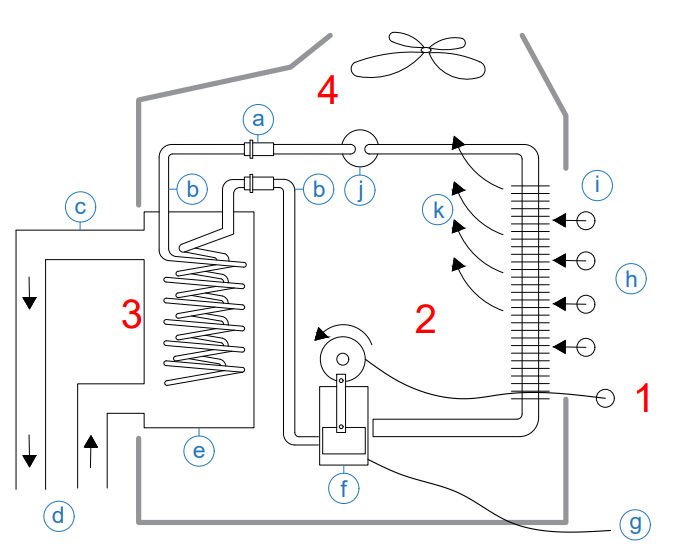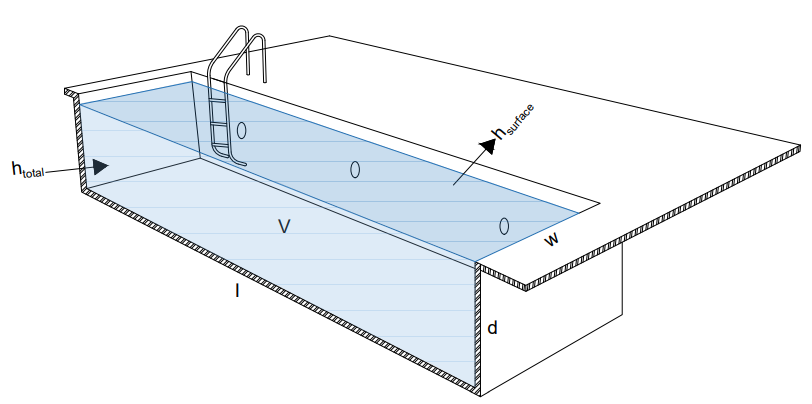- Last updated Oct 12, 2021
- Swimming Pool, Heating
Heat Pump
Introduction
A heat pump is a device that uses a small amount of energy to transfer heat from one place to another. Heat pumps used for heating pools convert heat from the outdoors to the water. Because they use the heat that already available and just transfer it from one place to another, they use less electricity.
Working principle
A pool heat pump uses electricity not only to generate heat but also have a fan which draws in heat from the air outside that has been warmed by the sun. This warm air is sucked in by a fan and is circulated through an outer evaporator air coil. Liquid refrigerant within the evaporator coil absorbs heat and transforms into warm gas. The warm gas in the coil then gets pumped into the compressor which then increases the heat, producing a very hot gas which then passes through the heat exchanger condenser. The pool pump circulates the swimming pool water drawn from the pool, it then passes through a filter and the heat pump.


As the hot refrigerant gas and water from the pool is pumped through the heat exchanger of the heat pump at the same time, the hot gas transfers its heat to the water. The water is heated around 2-4 degrees as it passes through the heat exchanger and then the warmer water flows back into the pool. The hot refrigerant gas, as it flows through the condenser coil, returns to liquid form and back to the evaporator, where the whole process begins again. Heat pump water heaters work efficiently as long as the temperature outside remains around the 5 – 10 ºC range. The cooler the air outside, more is the energy they use. However, since most people use outdoor swimming pools during warm weather, this usually won't be an issue.
Sizing a heat pump
Heat pumps are more expensive than gas pool heaters, but they have a lower annual operating cost due to their increased efficiency. With proper maintenance, heat pumps will generally last longer than gas pool heaters. So, you will save more money in the long run. When choosing a heat pump, we must consider the size, efficiency and cost.
You must have a professional in-order trained to do the right size analysis for your specific swimming pool to determine the size of the pool heater. The size of a heat pump includes many factors.
- Air Temperature
- Surface area of pool
- Depth of pool
- Surface area of wall and floor
- Thickness of wall insulation
- Desired water temperature
- Ground temperature at the deepest point
- Air temperature
- Maximum running time
- Relative humidity
- Wind speed at location
- Solar insulation level
- Conductivity of wall material
- Conductivity of pool cover
- Thickness of pool cover
Therefore, pools located in areas with high average wind speeds and low humidity and cold nights on the surface of the pool usually require a large heater. Use the following instructions to calculate the heat load (kW) required for your heat pump. The total heat required to increase and maintain the temperature in a pool can be calculated as follows;
h (total) = h (surface) + h (heat-up),
Where
h (total) = Total heat load (kW)
h (surface) = Heat loss from surface of the pool - mainly water evaporation (kW)
h (heat-up) = Heat load required to increase the pool temperature (kW)

Heat-up load
The heat-up load depends on the volume of the pool.
h (heat-up) = ρ Cp l w d (dT / dt )
where,
h (heat-up) = Heat flow rate required (kW kJ/s)
ρ = 1000 - Density of water (kg/m³)
Cp = Specific heat water (4.2 kJ/kg 0C)
l = Length of swimming pool (m)
w = Width of swimming pool (m)
d = Depth of swimming pool (m)
dT = Difference between initial and final temperature (0C)
dt = Heat up time (s)
Surface heat loss due to temperature difference
The heat load required to change the surface heat loss due to the temperature difference between the surface of the pool and the ambient air can thus be expressed as,
h (surface) = Ks dT (aw) A
Where Ks = surface heat loss factor - average wind speed 5 km/h to 10 km/h
dT (aw) = temperature difference between pool air and surface water ( oC)
A = pool surface area (m2)
Note that most of the heat loss from the surface of a swimming pool is the result of water evaporating from the surface.
Example - Heat-up Load
The heat-up load for a swimming pool with dimensions 7 m x 5 m x 1.5 m, heated from 15oC to 28oC in 72 hours, can be calculated as,
h (heat-up) = (1000 kg/m³) (4.2 kJ/kg oC) (7 m) (5 m) (1.5 m) ((28 oC) - (15 oC)) / ((72 hours) (3600 s/hours))
h (heat-up) = 11.06 kW
If the ambient temperature is 18 oC and the wind conditions is moderate, the heat loss through the surface due to temperature difference (when the pool is heated up) can be calculated as,
h (surface) = (0.025 (kW/m2 0C) ((20 oC) - (18 oC)) (12 m) (6 m) = 3.6 kW
h (total) = h(surface) + h(heat-up)
h (total) = 11.06 + 3.6 = 14.65 kW
There the size of heat pump required is 14.65 kW